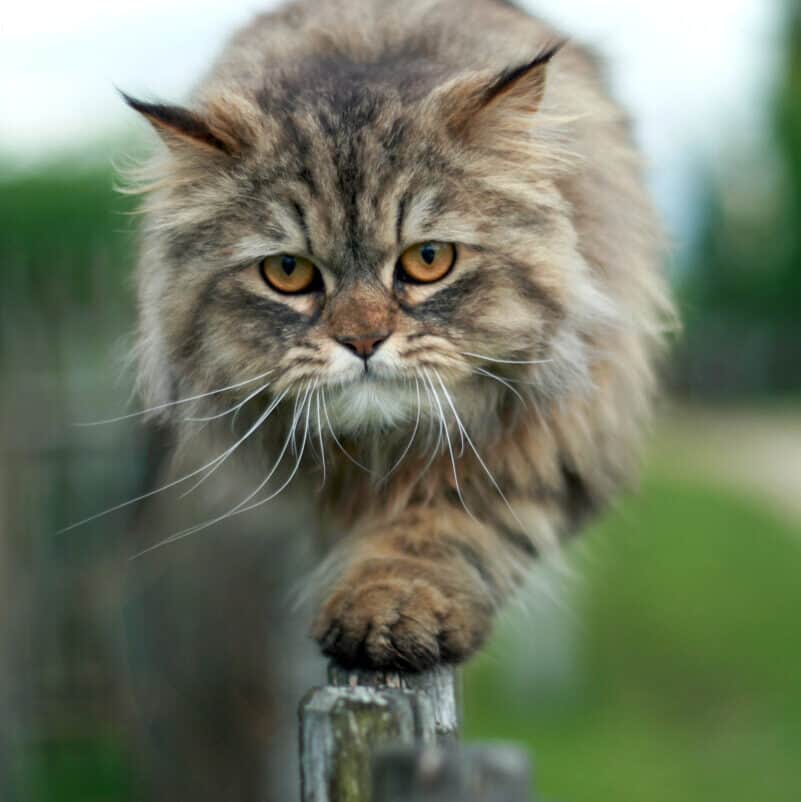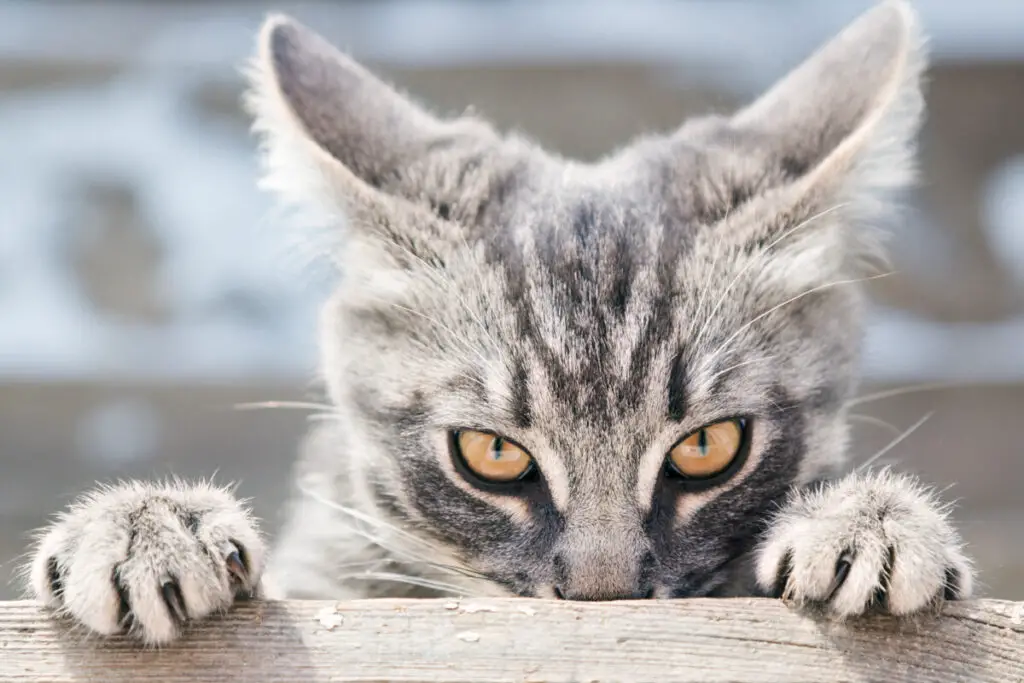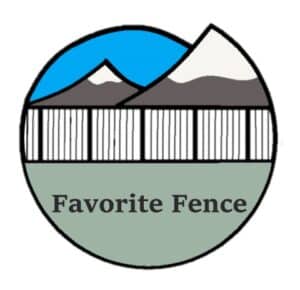Many cat owners explore ways to allow their favorite feline friends to safely bask in the sun, play, climb, and enjoy the outdoors. Containment options vary greatly depending whether the cats are intended to be able to have free-rein throughout the entire yard space or enclosure in a designated area. This post has been designed to help you find a cat enclosure system that meets your cat’s needs within the space that you have available to offer.
Within this post I will explore what type of fence is best to deter a cat from climbing, the best cat-proofing systems that can be added to an existing fence, highly rated portable and standalone pet enclosures and catios.
Free-Rein
The Best Fence To Keep Cats from Climbing
I recently installed a vinyl fence for a homeowner whose top priority was to deter neighborhood cats from scaling into their yard. After exploring the client’s needs and objectives, we were able to install a fencing solution that exceeded expectations.
Out of all fencing options, vinyl is the most effective to deter cats from climbing. Vinyl fencing is dense and nonporous making it nearly impossible for cats to use their sharp claws to gain climbing leverage. Enclosures can be mounted to the top and bottom of vinyl fencing to cat-proof property perimeters.
How to Keep My Cat in the Yard?
Usually, installing a fence involves enhancing curb appeal, creating privacy, and establishing a safe enclosure. There are many beautiful fencing solutions that homeowners can consider to meet these needs. However, when it comes to cat containment, a standalone fence may not be sufficient.
To keep cats in the yard, it is important to ensure the cat cannot climb the fence or gain access to the top with a single vertical leap. Also, ensure there are no features that provide advantage for scaling up and over and that there are no points of access below the fenceline.
A six-foot wood or chain-link fence will do little to deter cats, in fact, they almost invite cats to utilize their congenital instincts to climb and prowl from high places. A cat’s sharp hook-like claws cleave to wood and chain-link fencing like Velcro. Their exceptional climbing capabilities enable them to even pause mid-ascent to reassess their angle of approach or to leap to another obstacle.
If a homeowner has the objective to simply to deter cats from scaling the fence, a vinyl fence would be a good place to start. A vinyl privacy or semi-privacy fence will keep cats from climbing. However, a vinyl fence, alone, will not guarantee full containment.
Cats are agile, and naturally acrobatic. They quickly learn to dexterously maneuver through tight spaces, balance atop precarious vantage points, and walk along thin divides with drop-offs on either side, i.e. a fence.

Can a Cat Scale a Vinyl Fence?
Vinyl fencing prevents cats from climbing up and over the fence. Even the sharpest claws cannot penetrate the vinyl’s dense nonporous surface. Most cats cannot perform a vertical leap to summit the top of a six foot vinyl fence. However, the dexterous cat who can make the leap, while remarkable to observe, may require additional containment.
How High Can My Cat Jump?
Cats are genetically built to leap and bound large distances to surprise their prey or gain a perch atop a high vantage point. To determine if your cat may need additional containment features extended to the perimeter fencing, consider the following:
It is widely observed that cats can vertically leap 5 or 6 times their height—projected by their exceptionally strong hind quarters. To determine your cat’s maximum potential vertical leap, measure the height from your cat’s paw to the top of the shoulder and multiply the height by six.
If your cat has the ability to scale your fence with a single leap, or, if there are landscaping features that may give your cat an advantage, you will want to consider additional containment measures that can be mounted to the top of any fence. A fence-top containment system can be installed at the time of original fence installation or as an add-on to any existing fence. Home owners may choose to self-install the product or hire a fence installation contractor
The installation of a fence-top containment system can be technical and may require special tools. Even if you plan to install this yourself, it may be prudent to get a couple of bids from local contractors in order to better gauge the overall scope of the project and weigh the financial/labor pros and cons for self-installation.
The Domesticated Cat has a Stealthy Ancestral Lineage
The modern day domestic cat has a stealthy lineage sharing common ancestry with the wildcat, leopard, and jaguar. Even a kitten without a feline mentor, will begin exploring the capabilities of its feliform attributes. It will pounce and climb and find good use for those useful razor-sharp claws—handy inherited equipment for taking adventure straight up or straight into unsuspecting prey—like down into the oblivious couch cushion that never saw it coming.

How Does my Cat Keep Getting Over the Fence?
Homeowners, on both sides of the fence, who want to create an unscalable property perimeter for cats and other animals will have to consider the vertical and horizontal access to the top of their fence. Cats are by nature stealthy and persistent—when there is a will, there is a way.
If you give a cat an inch, it can scale a fence. Most cats have a leaping distance from 6 to 8 feet. Any backyard feature that provides even a few inches of advantage can be leveraged to extend a cat’s remarkable acrobatic capabilities to scale up and over a fence.
To reduce a cat’s ability to climb a vinyl fence, it may be prudent to move any objects from the cat’s access range. Tree branches and hedges may need to be trimmed back away from the fence. Large rocks may need to be relocated. Playground equipment and other items may need to be repositioned.
However, some static features around the home or fenceline may be permanently installed or impossible to move—such as air conditioning units or utility boxes, trees, or large boulders. Fence-top containment systems can be used around these areas to prevent a cat’s access on or around these areas.
Fence-top Cat Containment Systems that Really Work
After all things considered, if your cat is extremely dexterous and acrobatic and can summit a fence with a single leap, or there are static backyard features that cannot be trimmed back or moved, it may be prudent to consider installing a fence-top containment system.
- Purrfect Fence makes the best fence conversion products that can be added to any type of fence and will create a cat-proof fence-top barrier to prevent cats from scaling up and over the fence. It features a mesh extension with extension arms designed to flex down when carrying the weight of a cat. This downward motion not only makes the meshing extremely difficult to negotiate, it also creates a sense of high instability that causes a cat to drop down from the fence.
- Easy Pet Fence offers a well made bracket and mesh fence extender that can also be mounted to most existing fences. It is designed to extend out and away from the fence to deter even the most acrobatic cats from scaling over. However, it does not have a breakaway system.
- Oscillot makes a coyote roller that can be installed on the top of most existing fences. It is one of the most aesthetically unobtrusive solutions for cat-proofing the top of fencing and other home features. With an oscillating aluminum paddle-roller design, it prevents cats from cleaving and gaining the leverage needed for mounting and crossing over fencing and other obstacles. Some homeowners will just install coyote rollers on or near high-risk areas such as on the gate, above an A/C unit, etc.
How big of a gap can a cat squeeze through?
A six foot vinyl fence may be tall enough to prevent a cat from scaling up and over. But is it low enough to keep cats from sneaking under?
Cats have the remarkable ability to squeeze through tight spaces. Because cats have floating clavicles, their collar bone is only attached to muscle—allowing tremendous skeletal flexibility. Cats can contort themselves through any space wide enough to slip its head through.
This makes the bottom of a fence highly susceptible to cat crossings. Generally, the bottom rail of a vinyl fence should not be set more than two inches above the ground. However, if the bottom rail exceeds this clearance due to poor installation, uneven ground or landscape suppressions it may provide in and out access for cats to squeeze through.
It may be necessary to bring in fill to close the gap. Listed below are a few Amazon links to additional products that can prevent access below the fenceline:
Mesh grating or chicken wire: This can be affordably purchased and staked into the ground to prevent pass-through access.
Landscape Border Edging Kit: More decorative option for closing the gap between the bottom rail of the vinyl fence.
Dig Defense Barrier: Great solution for small sections of fence that have gaps that need to be protected from animals passing through. Easily installed. Comes in 32 in lengths.
Amagabeli 1/2 Hardware Cloth: Galvanized square metal netting that can be trimmed to the length and width desired. If your cat likes to dig and borough, metal netting can be easily installed 6 to 8 inches into the ground by digging a small trench.
The Vinyl Fence Solution For Cat Containment Requires Planning
Vinyl fencing offers the best fencing solution for preventing cats from scaling. When planning the installation of a vinyl fence around your property, make sure you consult with your contractor about your cat concerns. Ensure the fence is installed as low to the ground as possible—within manufacturer’s recommendations.
The contractor will be mostly focused on ensuring the fenceline is level and plumb. However, there may be additional installation options available for variable terrain to minimize the bottom rail gap from the ground—such as slight alterations to the fenceline, pre-installation excavation or the use of bottom rail extensions.
Enclosure
Enclosure Containment for Cats: Portable or Stand-Alone?
As an alternative to full free-rein of the backyard space, many homeowners create cat-pen enclosures to allow their cat space for outdoor play and enjoyment in a smaller designated area.
The best cat containment enclosures will meet the homeowner and cat’s needs for space, durability, portability and access.
Highly Rated Portable Cat Enclosures: Set-up in Seconds
Portable cat enclosures are a convenient way to allow cats outdoor exposure on demand. They require minimal storage space, offer quick setup, and can be used at any time. These enclosures are usually very small and highly ideal for those with limited yard space or those that are traveling. They offer a perfect solution for providing safe and instant outdoor time for feline travel companions.
However, if your cat does not travel well or is an escape artist who is destined to claw and chew their way out of containment, the portable enclosures may not be a good idea. They are made from lightweight nylon mesh—a feature that gives them portability at the expense of durability.
The following products provide examples of portable enclosures. Click on the link to go to Amazon to find pricing information:
Outback Jack Outdoor Cat Enclosure from Amazon is my favorite portable containment system. It is highly rated and has a unique quick set-up design for assembly in seconds. It includes a fun cat tunnel for additional outdoor play and enjoyment. It takes up minimal storage space and can be placed right up next to a doggy-door for your cat to travel in and out at will. If your cat is a good travel companion, consider bringing the Outback Jack Outdoor Enclosure on your next traveling adventure. Your cat will love you.
X-Zone Pet Playpen offered through Amazon is another great portable option that is also very highly rated. This playpen can also be assembled in seconds, offers more shade and has different size options from small to extra-large.
Fooubaby Cat Tent by Amazon is the most affordable highly rated option. The small tent pops up in seconds and gives the cat a small area to lounge around safely outdoors.
Stand Alone Cat Enclosures: Keep Your Cat Safe
Stand alone cat enclosures allow a homeowner to create a designated space in the yard for full cat containment. If the landscaping has variable terrain, the perimeter fencing isn’t ideal for cat proofing, or if there is only a specific area in which the cat is intended to roam, a standalone cat enclosure is going to be the best solution.
The best standalone cat enclosures allow worry-free outdoor enjoyment, ensure safety from predators, last for years, and are relatively easy to install—all within a designated area.
- Purrfect Fence offers the best standalone cat enclosure system. The high quality materials are built to last. Spring loaded extension arms give under the weight of a climbing cat—ensuring the cat does not escape from up and over the fence. Heavy gage welding wire is used at the base of the fence as a chew guard to prevent cats from escaping under the fence. The system can be set up as an extension to the back of the home—allowing cats to enter and exit at will, or as a standalone unit in any specified location.
- Trident Fence’s Kitty Corral Free Standing Fence System is another highly recommended option for a standalone cat enclosure. This system is very durable and is also topped with inward facing extenders and a two foot high metal mesh chew guard at the base.
- Easy Pet Fence’s Kitty Corral is the most affordable option to consider as a standalone full cat enclosure. It features a metal mesh chew guard at the base to prevent cats from finding escape through the bottom of the fence. The extension arms are static and durable polypropylene meshing is simply draped over the top for cat containment.
The system setup for the aforementioned products is designed simply enough for the enthusiastic DIY homeowner. None of the systems require digging for post installation. However, hammering in the posts with a heavy sledge or heavy post driver can require very arduous labor. Installation may also require specialized tools such as: a tensioner, gripple tightener, post hole driver, hog ringer, cutter puller, etc. It may be prudent to consult a local fencing contractor or handyman to get an installation bid because of the necessary tools involved with installation and the mildly technical assembly and labor involved.
Catios Explored
Last, but definitely not least, is exploring the catio outdoor enclosure. Catios are full enclosure systems built with highly durable materials designed to provide a safe space for cats to bask in the outdoors. They can be as big or as small as desired and are often custom built for a specific location on a patio or deck. Homeowners will find a lot of enjoyment planning, designing and accessorizing catio systems.
There are many options for preassembled catios. I’ve listed three different varieties below from Amazon to give you some examples of the different kinds of catio systems available.
PawHut Large Wooden Outdoor Cat House: I like this example because it gives homeowners a simple example of what a customized catio system could look like and some of the features it could contain. This particular model is highly rated and has a weather-proof design with oversized access doors with a multi-tier mainstay.
Aivituvin Cat House: I love this cat house because it shows the potential for using vertical space—perfect for cats who love to climb. The overall dimensions are 71” L x 38” W x 71” H.
PawHut 87” x 41” Outdoor Metal Pet Enclosure: This last example is of a metal only enclosure—simplistic, with no added features.
One of the great capabilities of catios is to be able to customize and accessorize with a myriad of amenity options full of your cat’s favorite things. I’ve added Amazon links to several highly rated accessories below just to provide some fun examples:
Safe and Secure Outdoor Enjoyment for Your Cat
All in all, finding and creating the best cat enclosure is about establishing a safe and enclosed environment within your means—whether it be in an entire yard, on the go, or in a designated area—to give your cat the ability to play, climb, bask in the sun and enjoy the outdoors.











